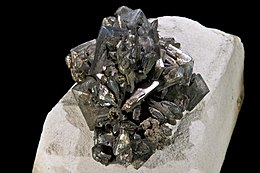
Back Markasiet Afrikaans مرقشيت Arabic Markazit Azerbaijani Марказіт Byelorussian Marcassita Catalan Markazit Czech Markasit German Μαρκασίτης Greek Marcasita Spanish Markasiit Estonian
| Marcasite | |
|---|---|
 Marcasite with tarnish (8×6 cm) | |
| General | |
| Category | Sulfide mineral |
| Formula (repeating unit) | FeS2 |
| IMA symbol | Mrc[1] |
| Strunz classification | 2.EB.10a |
| Crystal system | Orthorhombic |
| Crystal class | Dipyramidal (mmm) H-M symbol: (2/m 2/m 2/m) |
| Space group | Pnnm |
| Unit cell | a = 4.436 Å, b = 5.414 Å, c = 3.381 Å; Z = 2 |
| Identification | |
| Formula mass | 119.98 g/mol |
| Color | Tin-white on fresh surface, pale bronze-yellow, darkening on exposure, iridescent tarnish |
| Crystal habit | Crystals typically tabular on {010}, curved faces common; stalactitic, reniform, massive; cockscomb and spearhead shapes due to twinning on {101}. |
| Twinning | Common and repeated on {101}; less common on {011}. |
| Cleavage | Cleavage: {101}, rather distinct; {110} in traces |
| Fracture | Irregular/Uneven |
| Tenacity | Brittle |
| Mohs scale hardness | 6–6.5 |
| Luster | Metallic |
| Streak | Dark-grey to black. |
| Diaphaneity | Opaque |
| Specific gravity | 4.875 calculated, 4.887 measured |
| Pleochroism | [100] creamy white; [010] light yellowish white; [001] white with rose-brown tint. Anisotropism: Very strong, yellow through pale green to dark green |
| References | [2][3][4][5] |
The mineral marcasite, sometimes called "white iron pyrite", is iron sulfide (FeS2) with orthorhombic crystal structure. It is physically and crystallographically distinct from pyrite, which is iron sulfide with cubic crystal structure. Both structures contain the disulfide S22− ion, having a short bonding distance between the sulfur atoms. The structures differ in how these di-anions are arranged around the Fe2+ cations. Marcasite is lighter and more brittle than pyrite. Specimens of marcasite often crumble and break up due to the unstable crystal structure.
On fresh surfaces, it is pale yellow to almost white and has a bright metallic luster. It tarnishes to a yellowish or brownish color and gives a black streak. It is a brittle material that cannot be scratched with a knife. The thin, flat, tabular crystals, when joined in groups, are called "cockscombs".
In marcasite jewellery, pyrite used as a gemstone is called "marcasite" – that is, marcasite jewellery is made from pyrite, not from the mineral marcasite. Marcasite in the scientific sense is not used as a gem due to its brittleness. In the late medieval and early modern eras, the word "marcasite" meant all iron sulfides in general, including both pyrite and the mineral marcasite.[6] The narrower, modern scientific definition for marcasite as orthorhombic iron sulfide dates from 1845.[4] The jewelers' sense for the word "marcasite" pre-dates this 1845 scientific redefinition.
- ^ Warr, L.N. (2021). "IMA–CNMNC approved mineral symbols". Mineralogical Magazine. 85 (3): 291–320. Bibcode:2021MinM...85..291W. doi:10.1180/mgm.2021.43. S2CID 235729616.
- ^ "Marcasite". Mineralien Atlas (in German).
- ^ "Marcasite" (PDF). Handbook of Mineralogy. U. Arizona.
- ^ a b "Marcasite". Mindat.org. 2571.
- ^ "Marcasite". Webmineral. data.
- ^ "marcassite". CNRTL (in French).